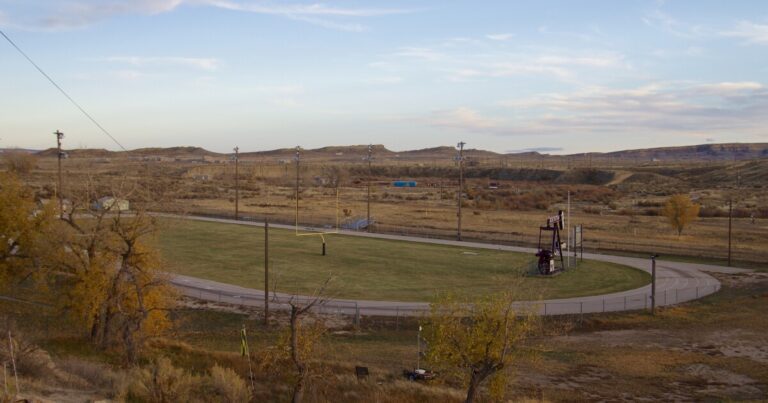For months, it was eerily quiet at Midwest School. Apart from the rustling of leaves in the enclosed parking lot, the only sounds are the clanking of the flagpole and the barking of the dog across the street.
It has been like this since May, when health officials closed the 120-student K-12 school after detecting dangerous levels of toxic gases inside.
Midwest, population 418, is in the middle of the Salt Creek oil field, the oldest in Wyoming. It quickly became clear that the gases were coming from the oil field, but no one knew exactly how they were getting into the school.
“It was really scary for us parents not knowing what was going on,” says Kellie Garbutt, a Midwest parent of two students, as she walks me through the school grounds on a recent afternoon.
Garbutt remembers the day this summer when a work platform was set up in the schoolyard as Halliburton trucks lined the driveway.
“What the hell is going on here?” he remembers thinking.
Eventually, it became clear: there was an abandoned, leaking well sitting right in the middle of the schoolyard.
“There are so many wells in this area,” says Jennifer Sutherland Bishop, coach of the school's volleyball team. “Would it take them that long to check it—years to check every single one of those wells—and the one that's giving us the biggest problem is on school property?”
In September, the Casper-Natrona County Health Department released the results of air quality tests from May. Carbon dioxide levels inside the school were 26 times higher than the recommended limit, rendering some areas of the school oxygen-deficient. Benzene levels, which can have serious short- and long-term health effects, it was 200 times the amount deemed safe by the Agency for Toxic Substances and Disease Registry, an arm of the Centers for Disease Control.
Health officials say it is extremely unlikely there will be permanent health effects, but Sutherland says it was scary nonetheless. Even so, he is not to blame for the school's recent misfortunes.
“It's an act of God, it's an act of nature,” he says.
But a leaking well is not natural. As soon as the wells give up, they are considered dead — they are not tracked, and many times they are not even marked. If not properly connected, they can act as pathways for gases that would normally be trapped deep underground.
Salt Creek is an old oil field, and a decade ago, to boost production, companies began pumping carbon dioxide into the field. The gas acts like a soap, helping to remove oil from the ground. But as a gas, carbon dioxide wants to rise, and the thousands of wells drilled in the field offer potential pathways if they're not properly sealed. And all of this eventually leads to the surface.
State records show the faulty well was drilled in the 1920s and plugged and abandoned in the mid-1980s.
All operators at Salt Creek were told to “make sure [wells] were repositioned if necessary or that the construction of the wells protects the environment and public health,” says Tom Kropatsch, deputy director of the Wyoming Oil and Gas Conservation Commission, which regulates the industry.
In this case, these safeguards clearly did not work. But when asked if the Commission is considering any rule changes to prevent another such leak, Kropatsch said: “The current rules are protective.”
The leak in the school yard appears to have been repaired. This summer FDL, the company that exploits the oil field, pumped more than 20 tons of cement into the well. Recent air samples from inside the school are normal, but there is no timetable for reopening the site. A new ventilation system must be installed to prevent any future leaks inside, and this can take months.
Currently, students are bused 45 minutes south to Casper. For many, that means waking up at 5 a.m. to catch a school bus and not getting home until 7 or 8 p.m. When school reopens, most parents say they are confident it will be safe. But it's unlikely to be the last time the Midwest has to deal with a leaking well.
“They keep coming across new wells that weren't properly plugged, never mapped, so no one had any idea they were there,” says Garbutt, a mother of two students.
This is true not only in the Midwest, but across the country. Of the more than 3 million wells in the United States, most are now abandoned. Many are located in areas that were once oil fields but are now suburbs. While carbon dioxide injection isn't done in most places, wells can leak gases like methane and benzene if they're not properly plugged, as Inside Energy has previously mentioned.
Few cities and counties have notification requirements when it comes to building near or on top of abandoned wells, and there's often no indication that there's a hole, thousands of feet deep, that could someday come alive again.
What's next? Read and listen to previous coverage of the problems that can arise from the construction of abandoned oil and gas wells. Check out our maps of abandoned oil and gas wells in Wyoming and Colorado.

